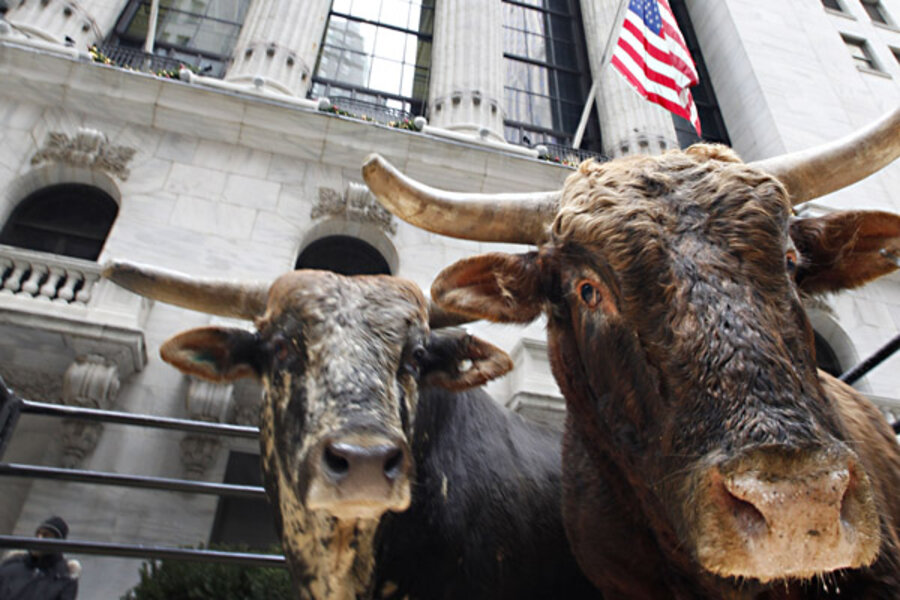The return of the bull market?
Loading...
Did you miss us, Dear Reader?
You won’t believe this…we hardly believe it ourselves…but after months of planning and preparation for our expedition to the high, dry mountains of Argentina, we’re still here in the city of Salta… Our project has been delayed…by floods.
As you may recall, it is so dry up at the ranch that visitors wonder what the cows eat. We tell them we have developed a new race of low-fat, low cholesterol cattle we call “sand fed beef.”
But what ho! Now we are still in Salta, a city about a 5-hour drive from the ranch, and we are stuck.
“Well…” says our foreman “…the road to Angastaco is blocked by the river. The road to Molinos is blocked by mud. But you don’t have to worry about that. You can’t get anywhere near there, because the road to Cafayate is impassable because of rockslides…and the road over the mountain pass has been washed out completely.”
Yes, dear reader, we have been hit by a low, unexpected blow…from water! The ranch got only 120 mm, or about 5 inches, of rain last year. The year before it was only about 4 inches. It looked to us as though the whole place was going to dry up and blow away.
But so far this year, the gods have poured 15 inches of water on that parched ground…and it keeps raining. Fifteen inches is not a lot. Not for Maryland. But up in the barren mountains, the water rolls of the rocks…down through the gullies…and fills the rivers. Soon, it is over its banks, floating automobiles and rolling boulders.
“They’re clearing the main road now,” says our friend. It should be passable tomorrow…if it doesn’t rain tonight. But getting from Cafayate up to your ranch is another matter. Nobody knows what has happened up there. They’ve been cut off for weeks.”
Hmmm…
And so, we cool our heels…we rest our heads…we pace the room and watch the skies…eager to see a ray of sunlight…and some hope of proceeding to our objective.
And so…we have time to reckon after all.
And we reckon that investors are in ‘hope mode.’ How else to explain the recent bullishness? Albert Edwards elaborates:
One key lesson from Japan is that an essential ingredient to the end of a long valuation bear market is revulsion. It is when “buyers-on-dips” become “sellers-on-rallies”. It is when volume dries up to almost nothing. It is the loss of hope. In Japan we saw huge rallies in the Nikkei on the back of short-lived cyclical recoveries. Each cyclical failure and further new lows in the equity market saw hope being progressively crushed. Previous US valuation bear markets typically take 4 or 5 recessions to fully play out. We have only had two.
The market is once again in a hope phase — hoping that the US is now in a self-sustaining recovery; hoping that China might be soft-landing; hoping that the Greece bailout and the ECB liquidity polices have settled things down in the eurozone. These bursts of hope are essential in long bear markets. Essential in the sense that hope must be crushed. It will be crushed. Hope still beats in the breasts of equity investors. The market will rip out that hope and consume it in front of investors’ eyes. Only then can the bull market begin.
In our view, the real turning point came in the year 2000. That’s when America’s decline began to speed up. It’s when the credit-driven economy could no longer produce real jobs…or real GDP…or real wealth.
Stocks rose. But they were rising on a bubble of debt. Then, it was mostly private debt. Now, they rise again…this time on public debt.
Either way, it can’t last. Eventually, the bear market will resume…taking down the prices of assets until they are cheap again. At 16 times earnings, stocks are higher than usual…and earnings are at near record levels. We expect earnings to fall…and stocks to fall too… Then, they will keep falling…until they finally reach the bottom. Edwards:
A flattening of the profits cycle is exactly what you might expect as the easy, early cycle productivity gains come to an end. It is worth noting that the last time this occurred was just ahead of the start of the recession which the NBER date as having started in December 2007. Back then too, both markets and policymakers all felt the economy was still quite healthy. Indeed neither non-farm payrolls nor the headline ISM signaled the economy had already entered recession at the end of 2007 — indeed like now, payrolls actually accelerated in the second half of 2007, just as profits began to slip!
But we can’t reach the bottom of this cycle unless and until investors give up hope. As long as they have hope they will buy the dips, hoping to catch the next up-move. Only when they become convinced that there will be no move to the upside, will they stop buying the dips and prices can finally fall to their ultimate low.
Hope must be destroyed. Then, a real bull market can begin.
Bill Bonner
for The Daily Reckoning








